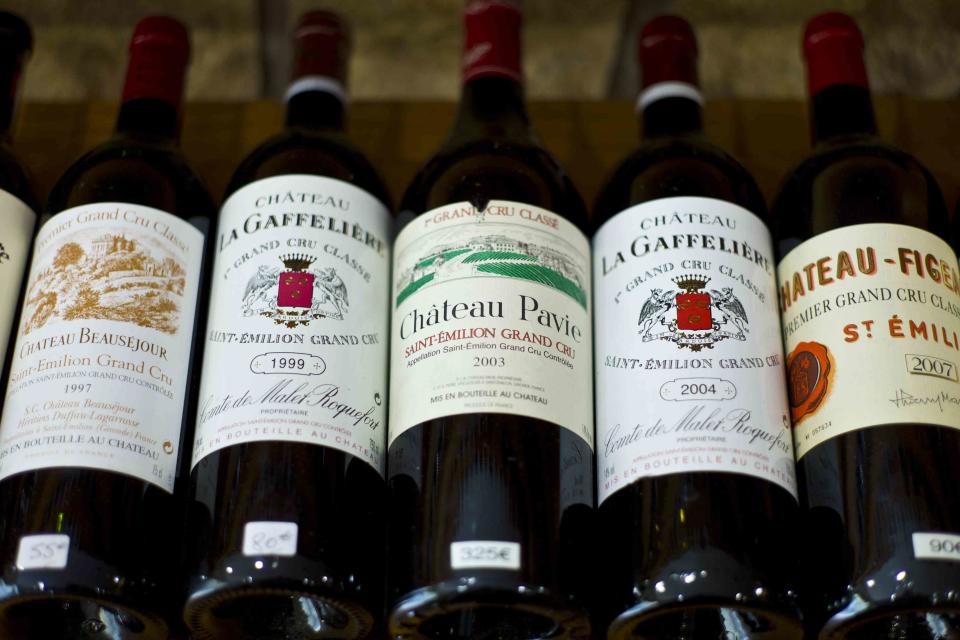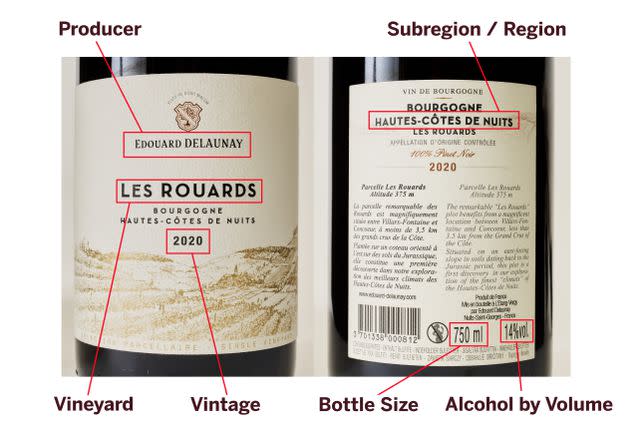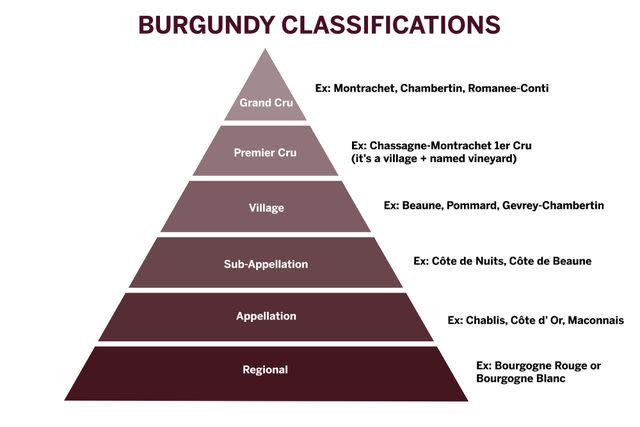How to Read a French Wine Label
Wine labels are confusing, but with some quick study, it's easy to sound like you know what you're talking about.

Tim Graham / Getty Images
France produces some of the world’s most renowned wines, crafted in a range of styles. The country has eleven major wine regions ranging from the Languedoc in the south to Champagne in the north, and laws governing wine production, honed over centuries, can differ from region to region. The result is that French wine labels, which are ostensibly meant to communicate to consumers what’s inside the bottle, have become a jumble of often confusing terms.
The broadest French wine laws apply to bottles labeled Vin de France (VDF), a category of table wines that can be made from grapes of any variety, harvested anywhere in the country. But beyond this base level, label requirements and terms can vary not just within regions, but within smaller appellations, and legislate everything from the shape of the bottle to what kind of grapes are permitted.
The best way to buy wine with confidence is to understand wine vocabulary. Let’s deconstruct a French wine label to identify what it means.

Food & Wine / Photo by Fred Hardy / Food Styling by Emily Nabors Hall / Prop Styling by Julia Bayliss
1. Who is the producer?
A wine’s producer is often listed alongside a graphic or a crest at the top of the front label. In Bordeaux, the producer is seen typically alongside a drawing of the chateaux.
The producer of the bottle above is Edouard Delaunay which is listed below their crest. A producer can be a single person or a larger brand with multiple winemakers, or even a brand that purchases wine and then bottles it under their own name.
Mis en bouteille à L'Étang-Vergy per Edouard Delaunay is listed in small print on this wine’s back label. This identifies that Delaunay made and bottled the wine, as opposed to just buying from another producer and putting their name on it. It was bottled in Nuits-Saint-Georges, a commune in the Côtes de Nuits.
"Consider the producer and the vineyard like the make and model of a car. "
2. What vineyard is this wine from?
Top quality French wines are often made from grapes of a single vineyard, or a selection of individual vineyard parcels. On the front label of this wine it says Les Rouards, the name of the single vineyard or sélection parcellaire where the grapes for this wine were grown. The back label further explains that this vineyard is planted at 375 meters of elevation.
Related: How to Find Terroir-Driven Wines
Consider the producer and the vineyard like the make and model of a car. In the case above, the producer Edouard Delaunay is like the car’s make (let’s say Jeep), while Les Rouards, the vineyard whose grapes were used to create the specific wine, would be the model (let’s call it a Wrangler). Wines made from individual vineyards by Edouard Delaunay all have connected style, in the same way all Jeeps share certain similar qualities and share an innate Jeep-ness, but each parcel expresses its character in a unique way, much the same as a Wrangler is vastly different than a Cherokee.

Food & Wine / Doan Nguyen
This hyper-specific labeling is sometimes called the “lieu-dit,” meaning “location-said.” Wine in Burgundy is incredibly terroir-dependent, meaning the specific plots of land where the grapes are grown can significantly impact the flavor. The region cares so deeply about these differences that the quality rating system is based on the land, not the producer.
Burgundy wine is typically organized into four levels, found on labels of wines from the region, sometimes referred to as the quality pyramid. The base is composed of regional wines often labeled with a subregion or the generic Bourgogne, followed by village appellations at the next level up, then premier cru, and finally topping out at grand cru. Each of these classifications refer to differences in where the vineyard is located on a hill or slope, what direction the vineyard faces (south and southeast are considered best), and how the soil is composed.
On the back label, Edouard Delaunay provides additional detail, telling us that the grapes were grown on an east-facing slope composed of ancient soils. This bodes well for the Les Rouards bottling — the grapes had ample sunlight light, and due to the slope, just enough water for the vines to spend energy producing and ripening fewer berries, yielding higher quality fruit.
Related: How to Find the Best Wines From Burgundy
3. Identify the wine region
In France, wines are labeled according to the place they were made, not grape variety, and consumers are expected to already be familiar with the grapes grown there.
Burgundy grows primarily Pinot Noir and Chardonnay, and in the Hautes-Côtes de Nuits those are the only two varieties allowed. Since this bottle is a red wine, it’s a given that it’s made with 100% Pinot Noir. Producer Edouard Delaunay does us a favor by noting the wine’s variety on the back label, but this is not common practice. Since France has eleven major wine regions, remembering what grapes a particular region grows takes some time to learn.
Burgundy: | Chardonnay and Pinot Noir (in Beaujolais, a sub-region in Southern Burgundy they grow Gamay) |
Bordeaux: | Structured, peppery reds made from Cabernet Sauvignon, Cabernet Franc, and Merlot; floral whites and dessert wines made from Semillon, Sauvignon Blanc |
Loire Valley: | Complex white wines made from Sauvignon Blanc, Chenin Blanc, and Melon Blanc; light-bodied reds made from Cabernet Franc |
Rhône: | Ageable reds often made from a blend of Grenache, Syrah, and Mourvedre |
Alsace: | Zippy, high acid whites and off-dry wines made from Riesling, Gewurztraminer, and Pinot Gris |
Languedoc-Roussillon: | Reds made from Carignan, Grenache, and Syrah |
Champagne: | Some of the world’s best sparkling wine made from Chardonnay, Pinot Noir, and Pinot Meunier |
Provence: | Light-pink rosé made from Grenache, Cinsault, and Mourvedre |
4. Is there a sub-region?
In the Delaunay example above, the subregion is listed as a specific village, but some simply name the broader appellation, and some wines are labeled even more broadly by region.
Here, the wine is made in the French region of Burgundy (also called Bourgogne) and, within that, Hautes-Côtes de Nuits, which is a village within the larger appellation Côtes de Nuits. This bottle is labeled Appellation d’Origine Contrôlé (AOC) which means it was produced within a certain designated area — in this case, Burgundy — in accordance with approved techniques for that region. The AOC rules are in place to maintain quality for products like wine, butter, or cheese, that are distinctly linked to a sense of terroir or place.
5. Who imports this wine?
Wines produced internationally must be brought in by importers to be sold in domestic U.S. markets. While some wines, like Delaunay’s, don't list the importer, many will note it on the wine’s back label.
While some larger-scale importers bring in a tremendous amount of wine from around the world, many have a more curatorial lens and focus on wine from a particular country or wines made in a specific style.
Think of importers like record labels. While there are a few major players dealing in popular wines, like Atlantic, Sony, or Universal are to music, many others specialize in niche styles, like Sub Pop, Matador, or Def Jam. This can be helpful to find wines you like but may be unfamiliar with, if they share an importer. For example, importer Jenny & Francois specializes in natural wine, while importer Olé & Obrigado brings in wines primarily from Spain and Portugal.
" The vintage refers to the year the grapes were harvested, not the year the wine was bottled."
6. What is the vintage?
The placement of the vintage on the label will vary — it might even be printed on the foil. The vintage refers to the year the grapes were harvested, not the year the wine was bottled. Some regions require wines to be aged in barrel or in the bottle for a certain amount of time before release, meaning you might be buying a new release that has 2020 on the label in 2024. In Burgundy, there are no aging requirements so it varies from producer to producer.
7. How much alcohol does this wine have?
Every bottle of wine produced in France is required to print on the label how much alcohol the wine contains. While the number printed is largely accurate, wines with 14% or less alcohol can list a number that’s within 1.5% of the actual amount, as long as it stays below 14%. This means the wine you buy that’s listed at 12% alcohol-by-volume, could actually be as high as 13.5% ABV.
For more Food & Wine news, make sure to sign up for our newsletter!
Read the original article on Food & Wine.

 Yahoo Lifestyle
Yahoo Lifestyle 
